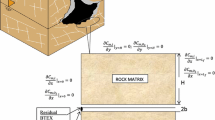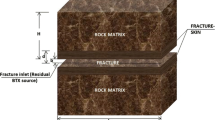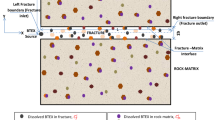Abstract
Dissolution from residual source zones of benzene poses serious threat to the groundwater quality. Proper understanding of fate and migration of dissolved benzene is a prerequisite for planning remediation strategies to reduce groundwater contamination. In the present study, an attempt has been made to numerically model the dissolution of benzene and to investigate the transport of aqueous phase benzene in a saturated fracture-matrix system under steady-state flow condition. In addition to dissolution mass transfer, advection, dispersion and matrix diffusion of aqueous benzene has been considered along the fracture. In the present numerical model, residual phase benzene is considered to be present along the entire length of the fracture and residual phase benzene is assumed to be immobile for the flow conditions considered in the analysis. Transport equations for fracture and rock-matrix are solved using implicit finite difference method. Transport equation for aqueous benzene within the fracture has been solved in a one-dimensional domain and transport equation for aqueous benzene within rock-matrix has been solved in a pseudo-two-dimensional domain. Sensitivity studies have been conducted to investigate the impact of variation of flow velocity, dispersivity, fracture aperture, inlet benzene concentration, rock-matrix diffusion coefficient, and half fracture spacing on transport of aqueous benzene concentration within the fracture. From the present study, it can be concluded that the addition of slow liquid benzene dissolution into aqueous phase influences the benzene breakthrough curves/profiles at different velocity, fracture aperture, initial benzene concentration, mass transfer rate, rock dispersivity and half fracture spacing.











Similar content being viewed by others
References
Aydin A (2000) Fractures, faults, and hydrocarbon entrapment, migration and flow. Mar Pet Geol 17(7):797–814
Barenblatt GI, Zheltov IP, Kochina IN (1960) Basics concepts in the theory of seepage of homogeneous liquids in fissured rocks. J Appl Math Mech 24:1286–1303
Bertin H, Panfilov M, Quintard M (2000) Two types of transient phenomena and full relaxation macroscale model for single phase flow through double porosity media. Transp Porous Media 39(1):73–96
Borden RC, Piwoni MD (1992) Hydrocarbon dissolution and transport: a comparison of equilibrium and kinetic models. J Contam Hydrol 10:309–323
Chu M, Kitanidis PK, McCarty PL (2007) Dependence of lumped mass transfer coefficient on scale and reactions kinetics for biologically enhanced NAPL dissolution. Adv Water Resour 30:1618–1629
Clement T, Gautam T, Lee K, Truex M, Davis G (2004) Modeling of DNAPL-dissolution, rate-limited sorption and biodegradation reactions in groundwater systems. Bioremed J 8:47–64
Coates JD, Chakraborty R, McInerney MJ (2002) Anaerobic benzene biodegradation-a new era. Res Microbiol 153(10):621–628
De Marsily G (1986) Quantitative hydrogeology. Academic, San Diego
Donald FL, Caroll LO, Ward CH (1999) Surfactants and co-solvents for NAPL remediation: a technology based manual. Lewis Pub. CRC Press, USA
Fillion E, Noyer ML (1996) Flow modelling in a dual porosity domain with automatic mesh generation and parameter calibration: application to the Äspö site. J Hydrol 180(1):1–19
Fingas MF (1998) Studies on the evaporation of crude oil and petroleum products II. boundary layer regulation. J Hazard Mat 57(1-3):41–58
Frind EO, Molson JW, Schirmcr M, Guiguer N (1999) Dissolution and mass transfer of multiple organics under field conditions: the Borden emplaced source. Water Resour Res 35:683–694
Garg S, Wixey WG (1999) The dissolution of benzene, toluene, m-xylene and naphthalene from a residually trapped non-aqueous phase liquid under mass transfer limited conditions. J Contam Hydrol 36(3-4):313–331
Grisak GE, Pickens JF (1980a) Solute transport through fractured media. I: the effect of matrix diffusion. Water Resour Res 16(4):719–730
Grisak GE, Pickens JF (1980b) Solute transport through fractured media. II: column study of fractured till. Water Resour Res 16(4):731–739
Hansen KS, Keuper BH (2014) A new model for coupled multicomponent NAPL dissolution and aqueous-phase transport, with application to creosote dissolution in discrete fractures. Water Resour Res 50:58–70
Imhoff PT, Arthur MH, Miller CT (1994) An experimental study of complete dissolution of a nonaqueous phase liquid in saturated porous media. Water Resour Res 30:307–320
Kim J, Corapcioglu MY (2003) Modeling dissolution and volatilization of LNAPL sources migrating on the groundwater table. J Contam Hydrol 65:137–158
Lahvis MA, Baehr AL, Baker RJ (1999) Quantification of aerobic biodegradation and volatilization rates of gasoline hydrocarbons near the water table under natural attenuation conditions. Water Resour Res 35:753–765
Lahvis MA, Hers I, Davis RV, Wright J, DeVaull GE (2013) Vapor intrusion screening at petroleum UST sites. Groundwater Monitor Remed 33(2):53–67
Lin TF, Van Loy MD, Nazaroff WW (1996) Gas-phase transport and sorption of benzene in soil. Environ Sci Technol 30(7):2178–2186
Moutsopoulos KN, Tsihrintzis VA (2009) Analytical solutions and simulation approaches for double permeability aquifers. Water Resour Manag 23(3):395–415
Nambi IM, Powers SE (2003) Mass transfer correlations for nonaqueous phase liquid dissolution from regions with high initial saturations. Water Resour Res 39:1–11
Neretneiks I (1980) Diffusion in the rock matrix: an important factor in radionuclide retardation. J Geophys Res 85(8):4379–4397
Osagie E, Owabor CN (2015) Adsorption of benzene in batch system in natural clay and sandy soil. Adv Chem Eng Res 5(3):352–361
Paul WH, Richard A (1991) Where’s the benzene - examining California groundwater quality surveys. Groundwater 29:1–6
Powers SE, Abriola LM, Weber WJ Jr (1992) An experimental investigation of NAPL dissolution in saturated subsurface systems: steady-state mass transfer rates. Water Resour Res 28:2691–2706
Powers SE, Abriola LM, Weber WJ Jr (1994) An experimental investigation of NAPL dissolution in saturated subsurface systems: transient mass transfer rates. Water Resour Res 30:321–332
Prommer H, Davis GB, Barry DA (2000) Biogeochemical transport modeling of natural and enhanced remediation processes in aquifers. J Land Contam Reclam 8(3):217–223
Ramalho AMZ, Sobrinho HLA, Anjos RB, Dantas TNC, Silva DR (2014) Study of contamination by benzene due diesel and gasoline leaks at a gas station in Natal/ Brazil. Int J Eng Tech 14(2):49–54
Renu V, Suresh Kumar G (2012) Numerical modeling and spatial moment analysis of solute mobility and spreading in a coupled fracture-skin-matrix system. Geotech Geol Eng 30:1289–1302
Renu V, Suresh Kumar G (2014) Temporal moment analysis of solute transport in a coupled fracture-skin-matrix system. Sadhana Indian Acad Sci 39:487–509
Robinson NI, Sharp Jr JM (1997) Analytical solution for contaminant transport in a 601 finite set of parallel fractures with matrix diffusion. C.S.I.R.O. Mathematical and 602 Information Sciences Report CMIS-C23
Robinson NI, Sharp JM, Ilan K (1998) Contaminant transport in a set of parallel fractures with fracture skin. J Contam Hydrol 31:83–109
Rogers RD, McFarlane JC, Cross AJ (1980) Adsorption and desorption of benzene in two soils and montmorillonite clay. Environ Sci Technol 14:457–460
Rubin H, Rathfelder K, Abriola LM (1997) Modeling quasi-steady state NAPL dissolution in fractured permeable media. J Env Eng 123(3):205–216
Saba T, Illangasekare TH (2000) Effect of groundwater flow dimensionality on mass transfer from entrapped non-aqueous phase liquid contaminants. Water Resour Res 36:971–979
Schaerlaekens J, Vanderborght J, Merckx R, Feyen J (2000) Surfactant enhanced solubilization of residual trichloroethene: an experimental and numerical analysis. J Contam Hydrol 46:1–16
Sekhar M, Suresh Kumar G (2006) Modeling transport of linearly sorbing solutes in a single fracture: asymptotic behavior of solute velocity and dispersivity. Geotech Geol Eng 24(1):183–201
Sekhar M, Suresh Kumar G, Mishra D (2006) Numerical modeling and analysis of solute velocity and macrodispersion for linearly and nonlinearly sorbing solutes in a single fracture with matrix diffusion. J Hydrol Eng 11(4):319–328
Senthilkumar M, Sivasankar V, Gopalakrishna GVT (2013) Quantification of benzene in groundwater sources and risk analysis in a popular South Indian Pilgrimage City – a GIS based approach. Arab J Chem. doi:10.1016/j.arabjc.2013.09.022
Singhal BBS, Gupta RP (1999) Applied hydrogeology of fractured rocks. Kluwer Academic Pub, Dordrecht
Stiver W, Mackay D (1984) Evaporation rate of spills of hydrocarbons and petroleum mixtures. Environ Sci Technol 18:834–840
Sudicky EA, Frind EO (1982) Contaminant transport in fractured porous media: analytical solutions for a system of parallel fractures. Water Resour Res 18:1634–1642
Suresh Kumar G (2008) Effect of sorption intensities on dispersivity and macro-dispersion coefficient in a single fracture with matrix diffusion. Hydrogeol J 16(2):235–249
Suresh Kumar G (2009) Influence of sorption intensity on solute mobility in a fractured formation. J Environ Eng 135(1):1–7
Suresh Kumar G (2014) Mathematical modelling on transport of petroleum hydrocarbons in saturated fractured rocks. Sadhana Indian Acad Sci 39(5):1119–1139
Suresh Kumar G, Ghassemi A (2005) Numerical modeling of non-isothermal quartz dissolution/precipitation in a coupled fracture-matrix system. Geothermics 34(4):411–439
Suresh Kumar G, Sekhar M (2005) Spatial moment analysis for transport of nonreactive solutes in fracture-matrix system. J Hydrol Eng 10(3):192–199
Suresh Kumar G, Sekhar M, Misra D (2006) Time dependent dispersivity behavior of non-reactive solutes in a system of parallel fractures. Hydrol Earth Syst Sci Discuss 3(3):895–923
Tang DH, Frind EO, Sudicky EA (1981) Contaminant transport in fractured porous media: analytical solution for a single fracture. Water Resour Res 17(3):467–480
USEPA (2011b) National Emissions Inventory. Available at: http://www.epa.gov/ttn/chief/net/2005inventory.html#inventorydata
Van Biljon W, Germs W, Hassan L (2006) Monitored natural attenuation of petroleum hydrocarbons in a fractured environment- a case study. groundwater pollution in Africa. Taylor and Francis, Netherlands, pp 315–324
VanderKwaak JE, Sudicky EA (1996) Dissolution of non-aqueous phase liquids and aqueous phase contaminant transport in discretely fractured porous media. J Contam Hydrol 23:45–68
Vasudevan M, Suresh Kumar G, Indumathi MN (2014) Numerical study on kinetic/equilibrium behavior of dissolution of toluene under variable subsurface conditions. Europ J Env Civil Eng 18(9):1070–1093
Vogt C, Keinsteuber S, Richnow HH (2011) Anaerobic benzene degradation by bacteria. Microb Biotech 4(6):710–724
Warren J, Root P (1963) The behavior of naturally fractured reservoirs. Soc Pet Eng 228:245–255
Yang AL, Huang GH, Qin XS (2010) An integrated simulation-assessment approach for evaluating health risks of groundwater contamination under multiple uncertainities. Water Res Manag 24(13):3349–3369
Zhang W, Bouwer EJ (1997) Biodegradation of benzene toluene and naphthalene in soil-water slurry microsoms. Biodeg 8(3):167–175
Zhang J, Roegiers JC, Bai M (2004) Dual-porosity elastoplastic analyses of non-isothermal one-dimensional consolidation. Geotech Geol Eng 22(4):589–610
Author information
Authors and Affiliations
Corresponding author
Rights and permissions
About this article
Cite this article
Renu, V., Kumar, G.S. Numerical Modeling on Benzene Dissolution into Groundwater and Transport of Dissolved Benzene in a Saturated Fracture-Matrix System. Environ. Process. 3, 781–802 (2016). https://doi.org/10.1007/s40710-016-0166-y
Received:
Accepted:
Published:
Issue Date:
DOI: https://doi.org/10.1007/s40710-016-0166-y




